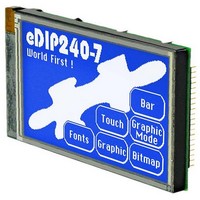EA EDIP240B-7LWTP ELECTRONIC ASSEMBLY, EA EDIP240B-7LWTP Datasheet - Page 8

EA EDIP240B-7LWTP
Manufacturer Part Number
EA EDIP240B-7LWTP
Description
LCD Graphic Display Modules & Accessories Blue/White Contrast With Touch Screen
Manufacturer
ELECTRONIC ASSEMBLY
Datasheet
1.EA_EDIP240J-7LATP.pdf
(21 pages)
Specifications of EA EDIP240B-7LWTP
Pixel Density
240 x 128
Fluid Type
STN Negative
Module Size (w X H X T)
113 mm x 70 mm x 13 mm
Viewing Area (w X H)
91.18 mm x 56.3 mm
Backlighting
White
Background Color
Blue
Operating Temperature Range
- 20 C to + 70 C
Attached Touch Screen
Yes
Style
LCD Graphic Display
Interface
RS-232, I2C BUS, or SPI BUS
Lead Free Status / RoHS Status
Lead free / RoHS Compliant
EA eDIP240-7
Page 8
DATA TRANSFER PROTOCOL (SMALL PROTOCOL)
The protocol has an identical structure for all 3 interface types: RS-232, SPI and I²C. Each data transfer is
embedded in a fixed frame with a checksum (protocol package). The EA eDIP240-7 acknowledges this
package with the character <ACK> (=$06) on successful receipt or <NAK> (=$15) in the event of an incorrect
checksum or receive buffer overflow. In the case of <NAK>, the entire package is rejected and must be sent
again.
Receiving the <ACK> byte means only that the protocol package is ok, there is no syntax
check for the command.
Note: it is neccessary to read the <ACK> byte in any case.
If the host computer does not receive an acknowledgment, at least one byte
is lost. In this case, the set timeout has to elapse before the package is sent
again.
The raw data volume per package is limited to 64 bytes (len <= 64).
Commands longer than 64 bytes (e.g. Load image ESC UL...) must be
divided up between a number of packages. All data in the packages are
compiled again after being correctly received by the EA eDIP240-7.
DEACTIVATING THE SMALL PROTOCOL
For tests the protocol can be deactivated by closing the solder strap J2 (see
page 20). In normal operation, however, you are urgently advised to
activate the protocol. If you do not, any overflow of the receive buffer will not
be detected.
BUILDING THE SMALLPROTOCOL PACKAGES
Command/Data to the display
Request for content of send buffer
<DC1> = 17(dec.) = $11
len = count of user data (without <DC1>, without checksum bcc)
bcc = 1 byte = sum of all bytes incl. <DC1> and len, modulo 256
<DC2> = 18(dec.) = $12
<ACK> = 6(dec.) = $06
len = count of user data (without <DC2>, without checksum bcc)
bcc = 1 byte = sum of all bytes incl. <DC2>, modulo 256
Example to a complete data package
<DC1>
>
<
>
<
<
$11
<DC1>
<ACK>
<DC2>
<ACK>
<DC1>
$0A
len
$1B $44 $4C $1B $47 $44 $00 $00 $EF $7F
len
len
Clear display and draw a line from 0,0 to 239,127
1
ESC D L
S
<ACK> = 6(dec.) = $06
1 = 1(dez.) = $01
ESC G D 0 0 239 127
bcc
data...
data...
S = 83(dez.) = $53
$DA
bcc
bcc
→
←
bcc
<ACK>
$06
The user data is transferred framed by
<DC1>, the number of bytes (len) and the
checksum (bcc). The display responds with
<ACK>.
The command sequence <DC2>, 1, S, bcc
empties the display’s send buffer. The display
replies with the acknowledgement <ACK>
and the begins to send all the collected data
such as touch keystrokes.
void SendData(unsigned char
{
}
SendByte(0x11);
SendByte(len);
SendByte(bcc);
unsigned char
for(i=0; i < len; i++)
bcc = 0x11;
bcc = bcc + len;
{ SendByte(buf[i]);
}
bcc = bcc + buf[i];
„C“ source code to transmit a data package
i, bcc;
Specifications may be changed without
prior notice. Printing error reserved
// Send DC1
// Send data length
// Send buf
// Send checksum
*buf,
unsigned char
len)




















